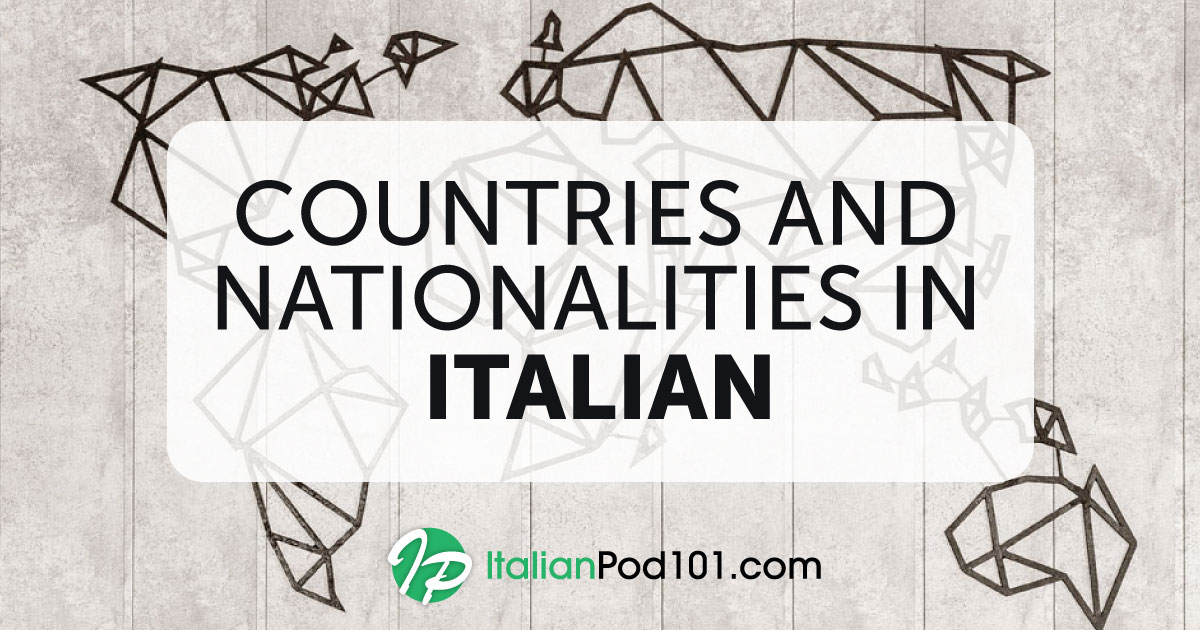
Verb tenses are absolutely necessary in clearly defining when a given action is taking place.
If you were to browse through any Italian grammar textbook or study an Italian conjugation table, you would probably find yourself overwhelmed by the number (21!) and apparent complexity of the tenses. And on top of that, each of the Italian tenses has to be conjugated for the six persons (io, tu, lui/lei, noi, voi, loro). This means that—unlike in English—every person of every tense has a different form.
But don’t worry, I have good news. Two pieces of good news, actually!
- To have a complete and meaningful conversation in Italian, you really just need to know three (3!) tenses: presente (present), passato prossimo (near past), and imperfetto (imperfect). You can also throw in the imperative, if you want, since it has pretty much the same form as the present.
- Even though every person of every tense is conjugated and has a different form, the basic forms of the conjugations (the verb endings) follow a very consistent and predictable pattern. Once you’ve memorized that pattern, you’ll be able to easily apply it to whatever verb and tense you need.
Of course, there are other verb tenses in Italian that are used to express more complex thoughts and concepts, but we can worry about those later on. Just keep in mind that you can alw/ays get by knowing just the three basic Italian tenses. Isn’t that wonderful?
- → Before we start, why not review the 100+ Most Important Italian Verbs?

Mangio una pizza. (“I’m eating a pizza.”)
 Table of Contents
Table of Contents
- Present Tense
- Past Tenses
- Future
- Conditional
- Are You in the Mood for Moods…? 😉
- Verb Conjugation and Auxiliary Verbs Summary
- Conclusion
1. Present Tense
The present tense in Italian is used to express an action happening right now, as we speak. It’s by far the most common and most frequently used tense in the Italian language.
| Mangio una pizza. | “I’m eating a pizza.” |
| Andiamo al cinema? | “Let’s go to the movies?” |
| Non lavoro la domenica. | “I don’t work on Sundays.” |
In addition to expressing actions happening right now, the Italian present tense is also commonly used to express the near future or the intention of doing something. Of course, there’s a specific tense for future (which we’ll see later on), but keep in mind that it’s extremely common in Italian to use the present tense to express a near-future intention or action.
| Domani vado a mangiare una pizza. | “Tomorrow I’ll go for pizza.” |
| L’estate prossima andiamo in vacanza in Sicilia. | “Next summer we’ll go to Sicily on vacation.” |
2. Past Tenses
When it comes to the past tense in Italian, it gets a bit more complicated. This is because there are actually two main Italian past tenses that we use depending on the situation. Here’s a brief overview with examples to make everything clearer.
A- Passato Prossimo
Passato prossimo (simple past) is the tense that expresses a specific action that happened in the past and ended in the past. The Italian passato prossimo is formed by combining the auxiliary avere (to have) or essere (to be) and the past participle, usually* ending in -ato, -uto, or -ito, respectively for the -are, -ere, and ire conjugations.

Hai studiato? (“Did you study?”)
| Infinitive | Past participle | Passato prossimo |
| Mangi-are (To eat) | Mangi-ato | Ho mangiato (I ate) |
| Cred-ere (To believe) | Cred-uto | Hai creduto (You believed) |
| Cap-ire (To understand) | Cap-ito | Ha capito (She understood) |
That’s not too hard to remember, right?
Just keep in mind that there’s a great number of verbs that have an irregular past participle, so you’ll have to memorize them. The good news is that some of them are so common that the memorization process will happen naturally. Also, they’re mostly of the -ere conjugation, so you should watch out for those.
Here’s a quick list of some must-know verbs that have an irregular past participle, along with their passato prossimo forms.
| Infinitive | Irregular Passato Prossimo | Infinitive | Irregular Passato Prossimo |
| Accendere | Ho acceso (I turned on) | Perdere | Ho perso (I lost) |
| Aprire | Ho aperto (I opened) | Prendere | Ho preso (I took) |
| Chiedere | Ho chiesto (I asked) | Ridere | Ho riso (I laughed) |
| Chiudere | Ho chiuso (I closed) | Rimanere | Sono rimasto/a (I stayed) |
| Correre | Ho corso (I ran) | Rispondere | Ho risposto (I answered) |
| Dire | Ho detto (I said) | Scendere | Sono sceso/a (I went down) |
| Essere | Sono stato/a (I was) | Scrivere | Ho scritto (I wrote) |
| Fare | Ho fatto (I did/made) | Spegnere | Ho spento (I turned off) |
| Leggere | Ho letto (I read) | Vedere | Ho visto (I saw) |
| Mettere | Ho messo (I put) | Venire | Sono venuto/a (I came) |
| Morire | Sono morto/a (I died) | Vivere | Sono*/Ho vissuto (I lived) |
| Nascere | Sono nato/a (I was born) |
| Ieri ho mangiato a casa di mio fratello. | “Yesterday, I ate at my brother’s house.” |
| Durante le vacanze sono andata** al mare tutti i giorni. | “During my vacation, I went to the beach every day.” |
| Hai letto il giornale di ieri? | “Did you read yesterday’s newspaper?” |
| Non abbiamo chiesto l’orario del treno… | “We haven’t asked for the train schedule…” |
You probably noticed that in the examples, the auxiliary avere (to have) was sometimes used and essere (to be) was used other times. Why? Well, this is rather common in Romance languages. So, if you’re familiar with French or Spanish, for example, this shouldn’t come as a surprise. Basically, you always use avere as an auxiliary, except when you have an intransitive verb.
What does “intransitive” mean?
Intransitive verbs cannot have a direct object and must be used with the essere auxiliary. These verbs often indicate movement or a change of state, such as:
- Andare (To go)
- Rimanere (To stay)
- Nascere (To be born)
- Morire (To die)
At the beginning, it might seem complicated—but don’t worry! With a little practice, choosing the right auxiliary will be really easy!
Another thing to remember: If you use the essere auxiliary in any compound tense, you need to make it agree with the subject. It’s easier to show than to explain:
Giovanni è andato a scuola. (Giovanni went to school.)
Maria è tornata dalle vacanze. (Maria is back from vacation.)
(Noi) Siamo nati in Italia. (We were born in Italy.)
Le mie amiche sono venute in treno. (My friends came by train.)
On the other hand, if you had a verb that uses the avere auxiliary, the ending always stays the same:
Giovanni ha studiato la lezione. (Giovanni studied the lesson.)
Maria ha mangiato un panino. (Maria ate a sandwich.)
(Noi) Abbiamo visto un bel film. (We saw a good movie.)
Le mie amiche hanno organizzato una festa. (My friends organized a party.)
Passato prossimo is often used with adverbs or phrases indicating time, such as:
- ieri (yesterday)
- l’altro ieri (the day before yesterday)
- la settimana scorsa (last week)
- un mese fa (a year ago)
- l’anno passato (last year)
So far so good? Then let’s get ready for the imperfetto.
B- Imperfetto
Imperfetto (imperfect) is a tense that exists in most Romance languages. It indicates a recurrent or usual action, an action that is still pending or not yet completed, or an ongoing action that occurred while another action happened. Basically, it’s an “imperfect” tense because it does not describe a definite, precise action of the past. It might be a little tricky at first, but you’ll soon get the hang of it.
When and how do we use it, then? The indicative imperfect is used…
- …to indicate an action not completed, which took place at the same time as another:
Quando sono entrato, stavi dormendo. (When I came in, you were asleep.)
Mentre andavo a scuola, ho incontrato una mia amica. (When I was going to school, I met a friend of mine.)
- …to indicate an action that was habitually repeated in the past:
Tutte le estati andavamo in Sicilia in treno. (Every summer, we used to go to Sicily by train.)
Il nonno veniva a trovarci tutti i giorni e ci portava le caramelle. (Grandpa came to visit every day and brought us candies.)

C’era il sole e gli uccellini cantavano. (“It was sunny and the birds sang.”)
- …to describe events, places, and people’s physical characteristics:
C’era il sole e gli uccellini cantavano. (It was sunny and the birds sang.)
Le montagne erano tutte coperte di neve. (The mountains were all covered with snow.)
Maria aveva i capelli neri e gli occhi verdi. (Maria had black hair and green eyes.)
Since we’re talking so much about the past… There’s another past tense that’s so remote people don’t really use it anymore when speaking: the passato remoto. It’s a simple tense, used today mainly in written texts such as history textbooks and Italian literature. That’s why it’s important to be able to recognize it.
Giulio Cesare fu un generale romano. (Julius Caesar was a Roman general.)
La ragazza andò via senza voltarsi. (The girl left without looking back.)
Quell’estate andammo al mare solo una volta. (That summer, we only went to the beach once.)
3. Future
As mentioned before, in Italian you can use the present tense when talking about the near future. So, if you’re talking about your plans for later in the day or the following week, you can simply use the present tense and let the temporal adverb communicate that it will happen in the future. For example:
Domani esco da scuola alle tre del pomeriggio! (Tomorrow I leave school at three in the afternoon!)
Domenica facciamo una gita in montagna. (On Sunday, we are going for a day-trip to the mountains.)
La settimana prossima faccio una festa, vieni? (Next week I am throwing a party, will you come?)
But that doesn’t work all the time. When you’re talking about the distant future or want to be more specific about a future event, you’ll have to use the future tense.
The future tense in Italian is easy to spot, as it’s formed by adding an ending to the verb’s infinitive stem.
| Infinitive | |||
| Future | parl-are (to talk) | legg-ere (to read) | sent-ire (to hear) |
| io | parl–erò | legg-erò | sent-irò |
| tu | parl–erai | legg-erai | sent-irai |
| lui/lei | parl–erà | legg-erà | sent-irà |
| noi | parl–eremo | legg-eremo | sent-iremo |
| voi | parl–erete | legg-erete | sent-irete |
| loro | parl–eranno | legg-eranno | sent-iranno |
Easy, right? Just keep in mind that you need to change the a into an e for the first conjugation (the one in -are):
- parlare >> parlerò
- mangiare >> mangerò
- volare >> volerò
Also remember that the first (io = “I”) and third (lui/lei = “he/she”) persons have an accent on the ending, which means you need to put the stress on that final vowel.
But you can notice that, apart from the vowel coming from the stem of the infinitive, all endings are the same for each of the three conjugations.
L’anno prossimo faremo un viaggio negli Stati Uniti. (Next year we will travel to the United States.)
Un giorno questa situazione cambierà. (One day this situation will change.)
Prevedo che nel 2021 l’economia crescerà. (I predict that in 2021 the economy will grow.)
Domani ci sarà il sole? (Will it be sunny tomorrow?)
Another common use for the future tense in Italian is to express a supposition or a doubt:
Che ora sarà? (What time can it be?)
Saranno le tre, le tre e mezza. (It is probably three, three and a half.)
Quanti anni avrà Maria? (How old can Maria be?)
Boh, avrà vent’anni. (Dunno, she’s probably twenty.)
And finally, we use the future tense in the main clause when we’re stating a very realistic hypothesis, such as:
Se non piove, uscirò. (If it doesn’t rain, I will go out.)
Se leggi il libro, capirai il film. (If you read the book, you will understand the movie.)

Se non piove, domani uscirò… (“If it doesn’t rain, I’ll go out tomorrow …”)
4. Conditional
Once you know how to conjugate the future tense, it’s very easy to use the conditional because it’s formed exactly the same way. Just use the stem from the infinitive (changing the a into e for the -are conjugation) and add the appropriate ending for conditional.
Conditional is very important because it’s one of the most common Italian tenses and it’s used to express many situations.
- A personal opinion:
Io voterei per l’altro candidato. (I would vote for the other candidate.) - A doubt:
Cosa dovremmo fare? (What should we do?) - A possibility:
Sono così stanca che potrei dormire per due giorni! (I’m so tired that I could sleep for two days!) - A desire:
Mangerei un gelato al cioccolato… (I would love a chocolate ice cream…)
Oggi andrei al cinema. (Today I would like/love to go to the movies.)
- A polite demand:
Potrei avrei un cappuccino? (Could I have a cappuccino?)
Vorremmo noleggiare un’auto. (We would like to rent a car.)

Vorrei noleggiare questa macchina! (“I wish to rent this car!”)
We’ve already talked about hypothetical sentences regarding very realistic situations. Another important use of the conditional is in hypothetical sentences where we’re stating something very unrealistic. Do you remember these examples? Let’s look at them from a different point of view:
Se non piovesse, uscirei. (If it weren’t raining—but it is!—I would go out.)
Se tu leggessi il libro, capiresti il film. (If you read the book—but you refuse to—you would understand the movie.)
Or:
Se fossi ricco, comprerei una casa al mare. (If I were rich—but I’m not!—I would buy a beach house.)
Se tutti andassimo in bici, non ci sarebbe traffico! (If we all rode bikes—very unlikely—there would be no traffic!)
If you’re asking yourself what tense the verbs piovesse, leggessi, fossi, and andassimo, are in, I’ll tell you right away that it’s the past subjunctive (congiuntivo passato). We’ll talk about it in a little bit.
5. Are You in the Mood for Moods…? 😉
We’ve just mentioned condizionale (“conditional”) and congiuntivo (“subjunctive”), but we need to back up a little here. These are not tenses, but rather modi (“moods”). In other words, they indicate the attitude of the speaker relative to the action expressed in the verb.
For example, if the action is real we use the indicative; if it’s possible, we use the subjunctive; if it’s subject to particular conditions, we use the conditional; and if we’re giving orders, we use the imperative. These are the four Italian finite moods, meaning that they’re conjugated for each person. Then there are three infinite moods which are invariable and don’t change with different subjects.
On the other hand, the tenses only refer to the time of the action (in the present, in the past, or in the future).
Here’s a table that represents all of the moods and tenses in Italian for my favorite verb: studiare (to study).
| FINITE MOODS | |
| Indicativo | |
| Presente (studio) Imperfetto (studiavo) Passato remoto (studiai) Futuro (studierò) | Passato prossimo (ho studiato) Trapassato prossimo (avevo studiato) Trapassato remoto (ebbi studiato) Futuro anteriore (avrò studiato) |
| Condizionale | |
| Presente (studierei) | Passato (avrei studiato) |
| Congiuntivo | |
| Presente (che io studi) Imperfetto (che io studiassi) | Passato (che io abbia studiato) Trapassato (che io avessi studiato) |
| Imperativo | |
| Presente (studia!) | |
| INFINITE MOODS | Infinito |
| Presente (studiare) | Passato(aver studiato) |
| Participio | |
| Presente (studiante) | Passato (studiato) |
| Gerundio | |
| Presente (studiando) | Passato(avendo studiato) |
6. Verb Conjugation and Auxiliary Verbs Summary
Now that we’ve taken into consideration the absolutely must-know Italian tenses (and had an overview of all the Italian moods and tenses), it’s time to look at how to form every Italian tense using the help of auxiliaries.
- → We’re not going to go into too much detail about conjugation, because if you want to know more about it, you just need to check out this fantastic article on the ItalianPod101 blog.

Gli ausiliari sono qui per aiutare. (“Auxiliaries are here to help.”)
Auxiliaries have lots of uses, as the name itself suggests: auxiliary = ausiliare = “to help.”
We’ve already seen how to choose between essere (to be) and avere (to have) when forming the passato prossimo. Now we can look at other tenses (and other moods) that you’ll need the help of auxiliaries to use. Here we go!
A- Reality [Indicative]
| Presente Studio perché mi piace l’italiano! (I study because I like Italian!) | Passato Prossimo Anche tu hai studiato italiano con ItalianPod101? (Have you also studied Italian with ItalianPod101?) |
| Imperfetto Da bambina giocavo con le macchinine. (As a child, I used to play with toy cars.) | Trapassato Prossimo Quando sono arrivato, erano partiti da un’ora. (When I arrived, they had left an hour before.) |
| Passato Remoto Il gatto saltò sul divano. (The cat jumped on the sofa.) | Trapassato Remoto Dopo che Cesare ebbe conquistato la Gallia, si riposò. (After Caesar had conquered Gaul, he rested.) |
| Futuro Da grande farò l’astronauta. (When I grow up, I will be an astronaut.) | Futuro Anteriore Dopo che avrò studiato uscirò con gli amici. (After I study, I will go out with friends.) |
B- Desire [Conditional]
| Presente Mangerei un chilo di gelato al cioccolato… (I would eat a kilo of chocolate ice cream…) | Passato Ieri mi sarebbe piaciuto andare al cinema. (Yesterday, I would have liked to go to the movies.) |
C- Doubt, Possibility [Subjunctive]
| Presente Penso che Carlos canti benissimo. (I think Carlos sings very well.) | Passato Penso che Carlos ieri abbia cantato meglio. (I think Carlos sang better yesterday.) |
| Imperfetto Pensavo che Carlos oggi cantasse in italiano. (I thought Carlos was singing in Italian today.) | Trapassato Ero convinta che Carlos ieri avesse cantato meglio. (I was convinced that Carlos had sung better yesterday.) |
D- Giving Orders [Imperative]
| Presente Studia se vuoi migliorare! (Study if you want to improve!) |
E- Indefinite Moods
The indefinite moods are verb forms that are only used in subordinate clauses, because they cannot stand alone in a sentence.
Infinitive
It indicates the pure action expressed by the verb. It ends in -are, -ere, ire.
- Correre è bello! (Running is fun!)
- Voglio andare al mare… (I want to go to the beach…)
Present participle
It usually turns the verb into a noun or an adjective (as in, the person or the thing doing the action). It ends in -ante, -ente.
- Il cantante è bravo. (The singer is good.)
Past participle
We already looked at this mood when talking about the passato prossimo. It’s the one ending in -ato, -uto, -ito that we use together with auxiliaries.
- Ho cantato tutto la notte. (I sang all night.)
Gerund
It’s used to indicate something that is in the process of occurring, often used with the verb stare. It ends in -ando, -endo.
- Sto cantando sotto la pioggia. (I’m singing in the rain.)
- Stai ancora dormendo? (Are you still sleeping?)
7. Conclusion
Verbs are like bricks that you need in order to speak full sentences. In this lesson, you learned enough tenses, moods, and verbal forms to build yourself a beautiful Italian villa!
How confident are you feeling about Italian verb tenses now? Feel free to reach out in the comments if you have any questions, and we’ll get back to you!
Don’t forget to browse through the many vocabulary lists with audio recordings and free resources available on our website. We make it easy to keep improving your Italian anywhere you are!
Remember that you can also use our Premium PLUS service, MyTeacher, to get personal 1-on-1 coaching and have your private teacher help you with tenses and conjugation. And that’s not all! With this service, you unlock 220+ hours of audio/video courses, study tools, bonus apps, and more. So you get the best of both worlds: access to a teacher and the ability to learn at your own pace with fast, fun, and easy lessons.
Keep learning while having fun with ItalianPod101.










